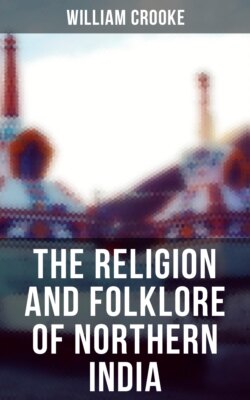Читать книгу The Religion and Folklore of Northern India - William Crooke - Страница 66
На сайте Литреса книга снята с продажи.
Worship of Bhûmiya.
ОглавлениеTable of Contents
One of the most characteristic of the benevolent village godlings is Bhûmiya—“the godling of the land or soil” (bhûmi). He is very commonly known as Khetpâl or Kshetrapâla, “the protector of the fields”; Khera or “the homestead mound”; Zamîndâr or “the landowner”; and in the hills Sâim or Sâyam, “the black one” (Sanskrit syâma). In the neighbourhood of Delhi he is a male godling; in Oudh Bhûmiyâ is a goddess and is called Bhûmiyâ Rânî or “soil queen.” She is worshipped by spreading flat cakes and sweetmeats on the ground, which having been exposed some time to the sun, are eventually consumed by the worshipper and his family. The rite obviously implies the close connection between the fertility of the soil and sunshine.
To the west of the Province the creation of Bhûmiya’s shrine is “the first formal act by which the proposed site of a village is consecrated, and when two villages have combined their homesteads for greater security against the marauders of former days, the people of the one which moved still worship at the Bhûmiya of the deserted site. Bhûmiya is worshipped after the harvests, at marriages, and on the birth of a male child; and Brâhmans are commonly fed in his name. Women often take their children to the shrine on Sundays, and the first milk of a cow or buffalo is always offered there.”38 Young bulls are sometimes released in his honour, and the term Bhûmiya sând has come to be equivalent to our “parish bull.”
In the Hills he is regarded by some as a beneficent deity, who does not, as a rule, force his worship on anyone by possessing them or injuring their crops. When seed is sown, a handful of grain is sprinkled over a stone in the field nearest to his shrine, in order to protect the crop from hail, blight, and the ravages of wild animals, and at harvest time he receives the first-fruits to protect the garnered grain from rats and insects. He punishes the wicked and rewards the virtuous, and is lord of the village, always interested in its prosperity, and a partaker in the good things provided on all occasions of rejoicing, such as marriage, the birth of a son, or any great good fortune. Unlike the other rural deities, he seldom receives animal sacrifices, but is satisfied with the humblest offering of the fruits of the earth.39
In Gurgâon, again, he is very generally identified with one of the founders of the village or with a Brâhman priest of the original settlers. The special day for making offerings to him is the fourteenth day of the month. Some of the Bhûmiyas are said to grant the prayers of their votaries and to punish severely those who offend them. He visits people who sleep in the vicinity of his shrine with pains in the chest, and one man who was rash enough to clean his teeth near his shrine was attacked with sore disease. Those Bhûmiyas who thus bear the reputation of being revengeful and vicious in temper are respected, and offerings to them are often made, while those who have the character of easy good-nature are neglected.40
In parts of the Panjâb41 Khera Devatâ or Chânwand is identified with Bhûmiya; according to another account she is a lady and the wife of Bhûmiya, and she sometimes has a special shrine, and is worshipped on Sunday only. To illustrate the close connection between this worship of Bhûmiya as the soil godling with that of the sainted dead, it may be noted that in some places the shrine of Bhûmiya is identified with the Jathera, which is the ancestral mound, sacred to the common ancestor of the village or tribe. One of the most celebrated of these Jatheras is Kâla Mahar, the ancestor of the Sindhu Jâts, who has peculiar influence over cows, and to whom the first milk of every cow is offered. The place of the Jathera is, however, often taken by the Theh or mound which marks the site of the original village of the tribe.
But Bhûmiya, a simple village godling, is already well on his way to promotion to the higher heaven. In Patna some have already begun to identify him with Vishnu. In the Hills the same process is going on, and he is beginning to be known as Sâim, a corruption of Svayambhuva, the Bauddha form now worshipped in Nepâl. In the plains he is becoming promoted under the title of Bhûmîsvara Mahâdeva and his spouse Bhûmîsvarî Devî, both of whom have temples at Bânda.42 In the Hills it is believed that he sometimes possesses people, and the sign of this is that the hair of the scalplock becomes hopelessly entangled. This reminds us of that very Mab “that plaits the manes of horses in the night and bakes the elflocks in foul sluttish hairs, which once untangled much misfortune bodes.”
It was a common English belief that all who have communication with fairies find their hair all tied in double knots.43 As we shall see later on, the hair is universally regarded as an entry for spirits, perhaps, as Mr. Campbell suggests, because it leads to the opening in the skull through which the dying spirit makes its exit. Hence many of the customs connected with letting the hair loose, cutting it off or shaving.
No less than eighty-five thousand persons declared themselves, at the last census, to be worshippers of Bhûmiya in the North-Western Provinces, while in the Panjâb they numbered only one hundred and sixty-three.
